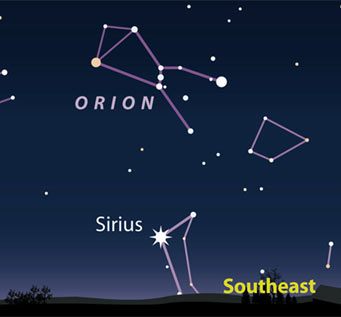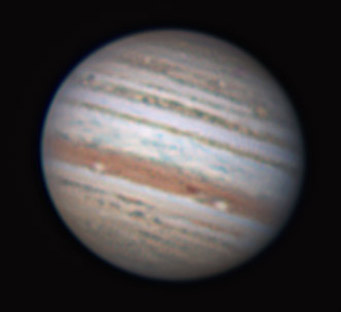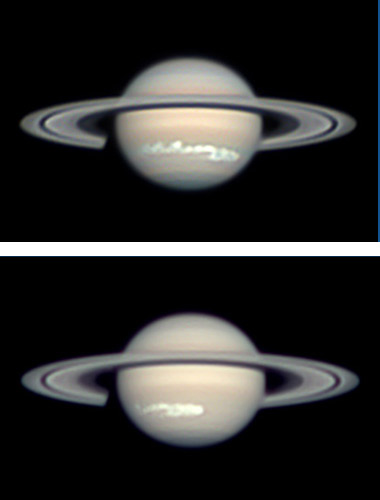
Orion's Belt points the way down to bright Sirius these evenings.
Sky & Telescope: Gregg Dinderman
Friday, January 14
Saturday, January 15
Sunday, January 16
Monday, January 17
Tuesday, January 18
Wednesday, January 19
Thursday, January 20
Friday, January 21
Saturday, January 22
Sky at a Glance is now an iPhone app! Put S&T SkyWeek on your iPhone, iPad, or iPod Touch and get the above listings anytime, anywhere — with interactive sky maps! Tap a button to see the scene described, customized for your location worldwide. From there you can scroll the view all around the sky, zoom in or out, change to any time or date, and turn on animation. Go to Apple's iTunes store from your device and buy S&T SkyWeek — just 99 cents!
Want to become a better amateur astronomer? Learn your way around the constellations. They're the key to locating everything fainter and deeper to hunt with binoculars or a telescope.
For an easy-to-use constellation guide covering the whole evening sky, use the big monthly map in the center of each issue of Sky & Telescope, the essential magazine of astronomy. Or download our free Getting Started in Astronomy booklet (which only has bimonthly maps).

The Pocket Sky Atlas plots 30,796 stars to magnitude 7.6 — which may sound like a lot, but that's less than one star in an entire telescopic field of view, on average. By comparison, Sky Atlas 2000.0 plots 81,312 stars to magnitude 8.5, typically one or two stars per telescopic field. Both atlases include many hundreds of deep-sky targets — galaxies, star clusters, and nebulae — to hunt among the stars.
Sky & Telescope
Once you get a telescope, to put it to good use you must have a detailed, large-scale sky atlas (set of charts). The standards are the Pocket Sky Atlas, which shows stars to magnitude 7.6; the larger Sky Atlas 2000.0 (stars to magnitude 8.5); and the even larger and deeper Uranometria 2000.0 (stars to magnitude 9.75). And read how to use your charts effectively.
You'll also want a good deep-sky guidebook, such as Sky Atlas 2000.0 Companion by Strong and Sinnott, or the more detailed and descriptive Night Sky Observer's Guide by Kepple and Sanner, or the classic if dated Burnham's Celestial Handbook.
Can a computerized telescope take their place? I don't think so — not for beginners, anyway, and especially not on mounts that are less than top-quality mechanically. As Terence Dickinson and Alan Dyer say in their Backyard Astronomer's Guide, "A full appreciation of the universe cannot come without developing the skills to find things in the sky and understanding how the sky works. This knowledge comes only by spending time under the stars with star maps in hand."
This Week's Planet Roundup

On the side of Jupiter without the Great Red Spot, the reviving South Equatorial Belt (SEB) displays as two starkly separated dark lines, just above center in this south-up image. The SEB north is thinner than the SEB south. Both are much grayer than the broad, very red North Equatorial Belt, which on this side continues to display prominent white ovals and a dark red mark.
Sky & Telescope's Sean Walker took this image on the evening of January 16, 2011, when System II longitude 41° was on the central meridian. Jupiter is not only moving farther from Earth but lower in the sky. "The seeing was fair for the low altitude (28°) when I shot," Walker writes. He used a 12.5-inch Newtonian telescope with a DMK 21AU04.AS monochrome high-speed CCD camera and Custom Scientific color filters. Photo of Walker and his scope.
S&T: Sean Walker
Mercury (still magnitude –0.3) is sinking back into the glow of dawn this week (for skywatchers in the Northern Hemisphere). Look for it low in the southeast, far lower left of bright Venus — the earlier in the week the better.
Venus (magnitude –4.5) blazes as the "Morning Star" in the southeast before and during dawn. In fact Venus rises some two hours before the first glimmer of dawn (for mid-northern latitudes) — a weird UFO of a thing low in the east-southeast. Once Venus is well up, look for much fainter Antares about 8° to its lower right or right.
Mars remains lost behind the glare of the Sun, and will be for months to come.
Jupiter (magnitude –2.2, at the Pisces-Aquarius border) shines well up in the southwest as the stars come out bit sinks lower later. It sets around 10 p.m. now. Get your telescope on it right at dusk when it's still high. Jupiter has shrunk to only 37 arcseconds wide as Earth rounds to the far side of the Sun from it. But do keep watch on Jupiter's South Equatorial Belt re-forming, a process that began in November.
Jupiter's Great Red Spot is near System II longitude 157°. Assuming it stays there, here are all of the Great Red Spot's predicted transit times until Jupiter disappears for the season.

If you haven't been watching Saturn before dawn, get out there! Its huge white outbreak, now a month old, has spread far around the planet and is easily visible in amateur telescopes when it's facing Earth — though not so vividly as in these extraordinary images. Don Parker in Florida shot them with a 16-inch reflector and a Luminera Skynyx II-0 camera on the morning of January 2, 2010, at 10:09 and 11:30 UT. "On these images the storm extends from 267° to 325° [System III longitude]," he writes. South is up.
Donald C. Parker
Saturn (magnitude +0.7, in Virgo) rises around 11 or midnight but is best seen in a telescope highest in the south before dawn. Don't confuse Saturn with Spica below or lower left of it.
In a telescope, Saturn's gigantic new white spot has spread far around the planet! See our article Saturn's New Bright Storm. Here are predicted transit times (through January 27th) for when the storm's original outbreak site crosses the center of Saturn's disk as seen from Earth.
Saturn's rings, meanwhile, have widened to 10° from edge on, the widest they've appeared since 2007. And see how many of Saturn's satellites you can identify in your scope using our Saturn's Moons tracker.
Uranus (magnitude 5.9) moves from 1.4&%176; to 2.4° west of Jupiter this week. (Actually, it's Jupiter that's moving east.)
Neptune (magnitude 7.9, at the Capricornus-Aquarius border) is sinking into the sunset.
All descriptions that relate to your horizon — including the words up, down, right, and left — are written for the world's mid-northern latitudes. Descriptions that also depend on longitude (mainly Moon positions) are for North America. Eastern Standard Time (EST) equals Universal Time (also known as UT, UTC, or GMT) minus 5 hours.
To be sure to get the current Sky at a Glance, bookmark this URL:
http://SkyandTelescope.com/observing/ataglance?1=1
If pictures fail to load, refresh the page. If they still fail to load, change the 1 at the end of the URL to any other character and try again.
 0
0
Comments
You must be logged in to post a comment.